
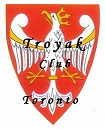
TROYAK EXECUTIVE TEAM is informing all members, colleagues, collectors, and Polonia at large, that Club meetings taking place at John Paul II Polish Cultural Centre, 4300 Cawthra Rd. (just south of Hwy. 403), Mississauga, Ontario. The new members are always welcome. www.polishculturalcentre.ca
ADRES SPOTKAÑ KLUBOWYCH ! Zarząd Główny Klubu “Troyak” informuje wszystkich członków kolekcjonerów, sympatyków oraz całą Polonię, że spotkania klubowe odbywają się w Polskim Centrum Kultury im. Jana Pawła II, przy 4300 Cawthra Rd. (na południe od autostrady 403), Mississauga, Ontario. Zapraszamy nowych członków do prężnego. Klubu “Troyak”. www.polishculturalcentre.ca

“TROYAK” CLUB NEXT MEETINGS …
NASTĘPNE SPOTKANIA KLUBU “TROYAK” …
23rd February 2020 @ 4:30 p.m.

8th March 2020 …
XVII Polish – Canadian Coin, Stamp & Collectibles Show 2020
29th March 2020 @ 4:30 p.m.
26th April 2020
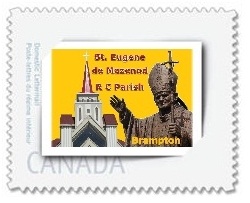
TROYAK CLUB @ St. John Paul II – 100
Birthday Anniversary Celebration 2020
Sunday 10 May 2020
9:00 a.m. to 4 p.m.
@
Our Lady Queen Of Poland Parish
Parafia Matki Bożej Królowej Polski
625 Middlefield Rd, Scarborough, ON M1V 5B8
Displays of Coins, Medals, Stamps, Collectibles dedicated to
St. John Paul II by Troyak Club Members.

TROYAK CLUB @ St. John Paul II – 100
Birthday Anniversary Celebration 2020
Saturday 16 May 2020 … 12:00 p.m. to 8:00 p.m.
Sunday 17 May 2020 … 9:00 a.m. to 8:00 p.m.
St. Casimir’s Church
www.kazimierz.org
Parish Hall … 156 Roncesvalles Ave. Toronto, ON M6R 2L4
Stamp Exhibit … Pope John Paul II on World Stamps and
displays of Coins, Medals, Collectibles dedicated to
St. John Paul II by Troyak Club Members.

TROYAK CLUB @ St. John Paul II – 100
Birthday Anniversary Celebration 2020
Sunday 24 May 2020
9:00 a.m. to 4 p.m.
@
John Paul II Polish Cultural Centre,
4300 Cawthra Rd. Mississauga, ON L4Z 1V8
Displays of Coins, Medals, Stamps, Collectibles dedicated to
St. John Paul II by Troyak Club Members.

TROYAK CLUB @ St. John Paul II – 100
Birthday Anniversary Celebration 2020
Sunday 31 May 2020
9:00 a.m. to 4 p.m.
@
Our Lady of Perpetual Help Catholic Church
Kosciół Matki Boskiej Nieustającej Pomocy
5 Oblate St. St. Catharines, ON L2M 5C5
Displays of Coins, Medals, Stamps, Collectibles dedicated to
St. John Paul II by Troyak Club Members.

31st May 2020
28th June 2020
![]()
July & August 2020 – Summer break … Letnie wakacje …

TROYAK CLUB @ Roncesvalles Polish Festival 2020
Saturday, September 12th … Sunday, September 13th, 2020
https://polishfestival.ca www.kazimierz.org

27th September 2020

4th October 2020 @ 9:00 a.m. to 4:00 p.m. …
Mississauga’s 5th Annual Fall Show
25th October 2020; 29th November 2020

Ludzie Kina i Teatru
People of cinema and theater
www.poczta-polska.pl
W dniu 25 października 2019 r. zostały wprowadzone do obiegu trzy znaczki pocztowe o wartości 3,30 zł każdy, emisji “Ludzie Kina i Teatru”. Na znaczkach przedstawiono: * 1. na pierwszym znaczku – Michała Znicza; * 2. na drugim znaczku – Jadwigę Andrzejewską; * 3. na trzecim znaczku – Józefa Węgrzyna. Znaczki wydrukowano techniką offsetową, na papierze fluorescencyjnym, w formacie 31,25 x 43 mm, po 249 000 sztuk każdego, w dwóch formach wydawniczych: * 1.w arkuszach sprzedażnych, zawierających 12 sztuk znaczków, wydrukowanych w nakładzie po 204 000 sztuk każdego znaczka; * 2.w arkusikach zawierających 3 znaczki, wydrukowanych w nakładzie 45 000 sztuk; Z tej okazji została wydana jedna koperta FDC. Autor projektu: Marzanna Dąbrowska.
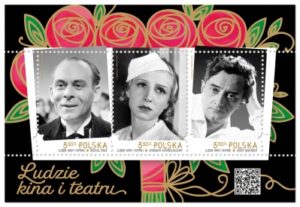
People of cinema and theater … denomination: 3,30 PLN;
number of stamps in set: 3; print run: 249.000 each pcs
(204000 pcs in 12 stamps sheet , 45000 pcs in 3 stamps block);
printing technique: offset; stamp size: 31,25 x 43 mm;
number of FDC: 1; author: Marzanna Dąbrowska;
circulation date: 25th October 2019.

100. Rocznica powstania polskich związków sportowych
100th Anniversary of the Establishment of Polish Sports Unions
www.poczta-polska.pl
Dnia 08 grudnia 2019 r. została wprowadzona do obiegu kartka pocztowa z nadrukowanym znakiem opłaty pocztowej, emisji: 100. rocznica powstania polskich związków sportowych. Wartość nominalna znaku opłaty pocztowej z oznaczeniem literowym A odpowiada wartości nominalnej znaczka pocztowego używanego do uiszczenia opłaty za ekonomiczną przesyłkę listową nierejestrowaną, w tym kartkę pocztową, w obrocie krajowym, w formacie S o masie do 500 g. W prawym górnym rogu strony adresowej kartki nadrukowano znak opłaty pocztowej, na którym przedstawiono biało-czerwone wiosło; wzdłuż górnej krawędzi znaczka umieszczono napis: POLSKA, a w prawym dolnym rogu oznaczenie wartości: A.
W części ilustracyjnej kartki umieszczono nazwę emisji: ,,100. rocznica powstania polskich związków sportowych”, a pod nią napis: POLSKI ZWIĄZEK TOWARZYSTW WIOŚLARSKICH oraz fotografię przedstawiającą zawodników dwójki podwójnej w składzie: Fabian Barański oraz Mirosław Ziętarski; w tle sylwetki wioślarzy. W prawym górnym rogu strony adresowej każdej kartki nadrukowano znak opłaty pocztowej, na którym przedstawiono: drewniane narty; wzdłuż dolnej krawędzi znaczka umieszczono napis: POLSKA, a w lewym dolnym rogu oznaczenie wartości: A, Kartkę o wymiarach 148 x 105 mm wydrukowano jednostronnie, techniką offsetową, na kartonie białym, w nakładzie 8000 sztuk. Autor projektu kartki: J. Konarzewski.
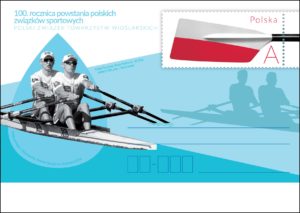
100th Anniversary of the Establishment of Polish Sports Unions … denomination: 3,30 PLN; number of stationeries in set: 1; print run: 8.000 pcs; printing technique: offset; card size: 148 x 105 mm; author: J. Konarzewski; release date: 08th December 2019.
Dnia 20 grudnia 2019 r. zostały wprowadzone do obiegu kartki pocztowe z nadrukowanym znakiem opłaty pocztowej, emisji: 100. rocznica powstania polskich związków sportowych. Wartość nominalna znaku opłaty pocztowej z oznaczeniem literowym A odpowiada wartości nominalnej znaczka pocztowego używanego do uiszczenia opłaty za ekonomiczną przesyłkę listową nierejestrowaną, w tym kartkę pocztową, w obrocie krajowym, w formacie S o masie do 500 g. Na kartce prezentującej POLSKI ZWIĄZEK PIŁKI NOŻNEJ, w prawym górnym rogu strony adresowej nadrukowano znak opłaty pocztowej, na którym przedstawiono: biało-czerwoną piłkę; wzdłuż górnej krawędzi znaczka umieszczono napis: POLSKA a w prawym dolnym rogu oznaczenie wartości: A. W części ilustracyjnej umieszczono: nazwę emisji ,,100. rocznica powstania polskich związków sportowych”, a pod nią napis: POLSKI ZWIĄZEK PIŁKI NOŻNEJ oraz fotografię przedstawiającą reprezentację Polski z 1924 roku, przed olimpijskim debiutem z Węgrami; w tle sylwetkę piłkarza oddającego strzał.
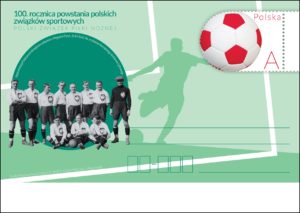
Na kartce prezentującej POLSKI ZWIĄZEK NARCIARSKI, w prawym górnym rogu strony adresowej kartki nadrukowano znak opłaty pocztowej, na którym przedstawiono: drewniane narty; wzdłuż dolnej krawędzi znaczka umieszczono napis: POLSKA, a w lewym dolnym rogu oznaczenie wartości: A. W części ilustracyjnej umieszczono: nazwę emisji ,,100. rocznica powstania polskich związków sportowych”, a pod nią napis: POLSKI ZWIĄZEK NARCIARSKI; fotografię przedstawiającą Adama Małysza oddającego skok na nartach, a w tle sylwetkę Justyny Kowalczyk. Kartki o wymiarach 148 x 105 mm wydrukowano jednostronnie, techniką offsetową, na kartonie białym, w nakładzie 8000 sztuk. Autor projektu kartki: J. Konarzewski.
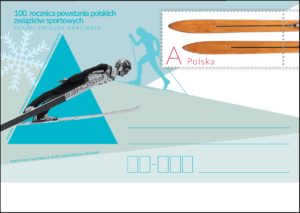
100th Anniversary of the Establishment of Polish Sports Unions … denomination: 3,30 PLN; number of stationeries in set: 2; print run: 8.000 pcs; printing technique: offset; card size: 148 x 105 mm; author: J. Konarzewski; release date: 20th December 2019.

Banknot kolekcjonerski 100-lecie powstania
Polskiej Wytwórni Papierów Wartościowych
www.nbp.pl
Polska Wytwórnia Papierów Wartościowych SA została powołana 25 stycznia 1919 r. decyzją Rady Ministrów pod przewodnictwem premiera Ignacego Jana Paderewskiego. Do 10 lipca 1926 r. funkcjonowała pod nazwą Państwowe Zakłady Graficzne. W tym samym roku rozpoczęto budowę nowego gmachu, przy ulicy Romana Sanguszki w Warszawie. Do dziś jest to główna siedziba PWPW. Historia firmy nierozerwalnie wiąże się z historią odradzającego się państwa polskiego i losami obywateli. Okresem szczególnej próby okazały się lata II wojny światowej. W zajętym przez okupanta gmachu działała konspiracyjna grupa PWB/17/S, złożona z pracowników Wytwórni, którzy z narażeniem życia kontynuowali produkcję banknotów oraz dokumentów na potrzeby Armii Krajowej.
W czasie Powstania Warszawskiego budynek PWPW był jedną z najważniejszych redut powstańczych. Po wojnie w odbudowanej siedzibie wznowiono produkcję, a kolejne pokolenia pracowników dbały o ciągły rozwój i modernizację firmy. Od 100 lat Wytwórnia pozostaje gwarantem bezpieczeństwa państwa polskiego i tożsamości jego obywateli. PWPW wytwarza doskonale zabezpieczone banknoty, dokumenty identyfikacyjne, znaczki pocztowe oraz kilkadziesiąt innych druków z kategorii security printing. Obecnie PWPW jest jedną z najnowocześniejszych na świecie firm zajmujących się produkcją papieru zabezpieczonego, banknotów oraz druków zabezpieczonych. Pozostając w służbie państwa polskiego, spółka z powodzeniem realizuje zamówienia krajowe oraz dynamicznie rozwija produkcję eksportową.
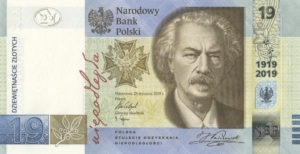
Nominał: 19 zł … Projektant: Justyna Kopecka; Wymiary: 150 mm x 77 mm; Nakład: do 55 tys. Sztuk; Na zlecenie NBP banknoty wyprodukowała Polska Wytwórnia Papierów Wartościowych S.A. Wszystkie monety i banknoty emitowane przez NBP są prawnym środkiem płatniczym w Polsce. Data wydania: 2-go października 2019 rok.
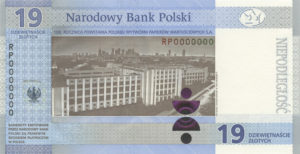
Z historią PWPW w szczególny sposób wiąże się postać jej patrona – Ignacego Jana Paderewskiego, jednego z ojców założycieli niepodległej Polski, wybitnego polityka, pianisty i filantropa. Był gorącym patriotą, zaangażowanym w działalność polityczną oraz społeczną w kraju i za granicą. Charakter tego męża stanu i wielką miłość do Ojczyzny najlepiej oddają jego słowa: „Nie zginie Polska, nie zginie! Lecz żyć będzie po wieki wieków w potędze i chwale. Dla was, dla nas i dla całej ludzkości”. Prezentowany banknot jest kolejnym z serii „Niepodległość”. Data umieszczona na banknocie, 25 stycznia 2019 r., to dzień, w którym przypada 100. rocznica powstania PWPW. Również wartość nominalna, 19 zł, nawiązuje do roku utworzenia Wytwórni. Banknotwyprodukowano na podłożu papierowym. Znak wodny przedstawia wizerunek orła z pierwszego polskiego banknotu wyprodukowanego w PWPW po odzyskaniu niepodległości.
Nowością jest pasek holograficzny umiejscowiony na okienku w podłożu. Strona przednia przedstawia portret Ignacego Jana Paderewskiego, a obok napisu „niepodległa” zaprezentowany został stylizowany wizerunek orderu Orła Białego. Napis ten, odwzorowany z rękopisu Józefa Piłsudskiego, jest logotypem obchodów 100-lecia odzyskania przez Polskę niepodległości. W gałązkę wawrzynu, symbolizującą braterstwo i zwycięstwo, wkomponowano zabezpieczenie opracowane przez PWPW – Umbra4Note , będące szczególną formą efektu kątowego. Na stronie odwrotnej banknotu umieszczono wizerunek gmachu Wytwórni na tle panoramy współczesnej Warszawy. Obok znajduje się wbudowane w logotyp PWPW zabezpieczenie SPARK Live oraz pasek opalizujący, widoczny również w świetle UV w postaci powtarzających się liczby „19” i skrótu „NBP”. Emisja banknotu kolekcjonerskiego upamiętniającego 100-lecie powstania Polskiej Wytwórni Papierów Wartościowych podkreśla szczególną funkcję, jaką PWPW pełni wobec państwa polskiego i jego obywateli. Informacja: Maciej Biernat Prezes Zarządu PWPW SA.

Collector banknote 100th Anniversary of
the Polish Security Printing Works (PWPW)
www.nbp.pl
The Polish Security Printing Works (Polska Wytwórnia Papierów Wartościowych – PWPW) was established on 25 January 1919 pursuant to the decision of the Council of Ministers headed by Prime Minister Ignacy Jan Paderewski. Until 10 July 1926, it operated under the name State Graphics Works (Państwowe Zakłady Graficzne). The construction of a new building at Sanguszki Street in Warsaw began in the same year. It continues to serve as the headquarters of PWPW to this day. The company’s history is inextricably linked to the history of the newly-reborn Polish state and the fate of its citizens. The years of the Second World War turned out to be a particularly challenging period. The PWPW building was seized by the Nazi occupiers but still served as the seat of the underground resistance group known as PWB/17/S. It consisted of PWPW’s workers, who risked their lives to continue the production of banknotes and documents for the needs of the Home Army.
During the Warsaw Uprising, the building of the Polish Security Printing Works became one of the most important insurrectionary redoubts used by the Polish freedom fighters. After the war, production was resumed in the rebuilt headquarters and the subsequent generations of employees worked to ensure the company’s continuous development and modernization. For 100 years PWPW has been guaranteeing the security of the Polish state and the identity of its citizens. PWPW produces perfectly secured banknotes, identification documents, postage stamps and dozens of other types of security prints. At present PWPW is one of the world’s most advanced companies involved in the production of security paper, banknotes, and secured prints. While remaining in the service of the Polish state, the company successfully implements domestic orders and dynamically expands its export production. The history of PWPW is strongly associated with the figure of its patron – Ignacy Jan Paderewski, an exceptional politician, pianist and philanthropist, and one of the founding fathers of independent Poland. He was an ardent patriot, engaged in political and social activities both at home and abroad. This statesman’s character and his great love for his country are best reflected by his own words: “Poland shall not perish! It shall not perish, but it will live forever in greatness and glory. For you, for us, and for all of humanity”.

Face value: 19 zł … Designer: Justyna Kopecka; Dimensions: 150 mm x 77 mm; Volume: up to 55,000 pcs; The banknotes, commissioned by NBP, were manufactured by the Polish Security Printing Works (PWPW S.A.). All coins and banknotes issued by NBP are legal tenders in Poland. Issued: 2nd October 2019.

The presented banknote is yet another collector item from the “Independence” series. The date printed on the banknote, 25 January 2019, falls on the 100th anniversary of the establishment of PWPW. Its face value of 19 zł is also a reference to the year in which PWPW was originally created. The banknote was produced on a paper substrate. The watermark depicts the image of the eagle from the first Polish banknote produced at PWPW after Poland regained independence. A new feature found here is a holographic stripe located over a see-through window in the substrate. The front side of the banknote carries a portrait of Ignacy Jan Paderewski, and a stylized image of the Order of the White Eagle is presented next to the inscription “niepodległa” (“independent”). This inscription, reproduced from Józef Piłsudski’s manuscript, serves as the logo of the official celebrations of the 100th anniversary of Poland regaining independence.
A special kind of latent image developed by PWPW, known as Umbra4Note , is incorporated into the image of a laurel branch symbolizing brotherhood and victory. The backside of the banknote carries the image of the PWPW building, presented against the backdrop of a panoramic view of contemporary Warsaw. Next to the image, there is the PWPW logo printed in the SPARK Live technology and an iridescent stripe, also visible under UV light, in the form of the number “19” and the abbreviation “NBP”, repeated alternately. The issue of the collector banknote commemorating the 100th Anniversary of the establishment of the Polish Security Printing Works emphasizes the special role that PWPW plays in relation to the Polish state and its citizens. Info: Maciej Biernat President of the Management Board of PWPW SA.

Odkryj Polskę – Kopiec Wyzwolenia
www.nbp.pl
Narodowy Bank Polski jest centralnym bankiem państwa odpowiadającym za politykę pieniężną i stabilność cen. Jego funkcje określa Konstytucja Rzeczypospolitej Polskiej i ustawa o NBP. NBP ma wyłączne prawo emisji pieniądza. Jako bank centralny nie prowadzi rachunków bankowych obywateli, nie przyjmuje od nich lokat, nie udziela kredytów. Prowadzi natomiast obsługę budżetu państwa, a także podmiotów sektora finansów publicznych. Gromadzi rezerwy walutowe państwa i zarządza nimi. Pełni funkcję banku banków, tworząc warunki do działania systemu bankowego. Jest również jednym z najważniejszych ośrodków naukowo-analitycznych w dziedzinie ekonomii i rynków finansowych. 7 listopada 2019 roku Narodowy Bank Polski wprowadził do obiegu monetę z serii „Odkryj Polskę – Kopiec Wyzwolenia” o nominale 5 zł.
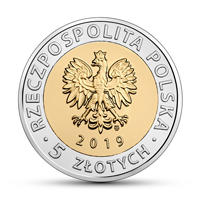
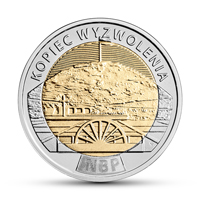
Nominał 5 zł … stop: pierścień MN25, rdzeń CuAl16Ni2;
stempel: zwykły; średnica: 24,00 mm; masa: 6,54 g;
brzeg (bok): moletowany nieregularnie; na boku ośmiokrotnie
powtórzony napis: NBP, co drugi odwrócony o 180 stopni, rozdzielony
gwiazdkami; nakład: do 1 200 000 szt.; Projektant awersu:
Dobrochna Surajewska; Projektant rewersu: Grzegorz Pfeifer;
Emitent: NBP; Na zlecenie NBP monety wyprodukowała
Mennica Polska S.A.
„Kopiec Wyzwolenia niech po wszystkie czasy stanowi widomy znak bohaterskich i zwycięskich czynów ludu śląskiego i jego wierności Ojczyźnie.” Fragment dokumentu wydanego z okazji uroczystości poświęcenia Kopca Wyzwolenia, 20 czerwca 1937 r.
Piekary Śląskie … Miejscowość jest położona na Górnym Śląsku, gdzie od dawna kultywowano polskie tradycje narodowe i pielęgnowano język polski. Wystarczy wspomnieć działalność proboszcza piekarskiego kościoła, księdza Alojzego Ficka (1790−1862) czy Teodora Heneczka (1817– 1888), górnośląskiego drukarza, redaktora i wydawcy. Piekary miały również ogromny udział w trzech powstaniach. Piekarscy powstańcy walczyli w różnych miejscach – szczególnie podczas III powstania śląskiego (1921), biorąc udział w walkach na Górze św. Anny. W tym samym powstaniu składano przysięgę powstańczą na tzw. Kocich Górkach, gdzie zginął pierwszy powstaniec. W okresie 20-lecia międzywojennego Piekary Śląskie znalazły się w granicach państwa polskiego.
Miejsce … Na krótko przed budową Kopca ustalono, że zostanie usypany na Kocim Wzgórzu (niem. Katzenberg), przez miejscowych zwanym Kocimi Łbami lub Kocimi Górkami. W tym miejscu przez wieki wydobywano rudy wielu metali. Drążono w tym celu wiele płytkich szybików, jeden przy drugim, a wydobyty urobek usypywano w sąsiedztwie. W ten sposób powstawały charakterystyczne, zaokrąglone nasypy ziemne, które przypominały kocie łebki.
Idea … Pomysł usypania kopca po raz pierwszy pojawił się w drugiej połowie XIX w. za sprawą Wawrzyńca Hajdy, miejscowego, ociemniałego górnika i działacza, zwanego Śląskim Wernyhorą. W jego zamyśle kopiec miał upamiętnić przemarsz wojsk króla Jana III Sobieskiego przez Piekary (1683) i wizytę władcy w miejscowej świątyni. Wówczas pomysł zarzucono, a władze pruskie aresztowały Hajdę za podburzanie ludności. Do idei powrócono dopiero w okresie 20-lecia międzywojennego, chcąc nie tylko upamiętnić królewskie czasy Sobieskiego, ale również powstańców śląskich. Do budowy kopca przystąpiono w 1932 r., a zakończono ją w 1937 r. Jego projektantem był inż. Eugeniusz Zaczyński. Kopiec usypano z kamieni i ziemi przywiezionej z różnych miejsc, w tym z miejsc uświęconych krwią Polaków. Uroczyste poświęcenie Kopca Wyzwolenia przy udziale władz państwowych nastąpiło 20 czerwca 1937 r. Jest to największy i najważniejszy na Górnym Śląsku pomnik upamiętniający powstania śląskie. Na rewersie monety znajdują się stylizowane wizerunki: Kopca Wyzwolenia w Piekarach Śląskich oraz fragmentu koła szybowego z kopalni „Julian”. Informacja: Dariusz Pietrucha.

Discover Poland – the Liberation Mound
www.nbp.pl
Narodowy Bank Polski is the central bank of the State, responsible for its monetary policy and price stability. The Bank’s functions are described in the Constitution of the Republic of Poland and the Act on NBP. NBP holds the exclusive right to issue the currency of the Republic of Poland. As the central bank, it does not provide accounts for the general public, accept deposits from or extend loans to individuals. It acts as a banker to the State budget and public sector entities. NBP also holds and manages the foreign exchange reserves of the State. Finally, it functions as a banker to banks, creating conditions for the operation of the Polish banking system. Narodowy Bank Polski is one of the most important research and analytical centres in the fields of economics and financial markets. On 7 November 2019, Narodowy Bank Polski issued into circulation a coin of the series “Discover Poland” – the Liberation Mound, with a face value of 5 zł.


Face value: 5 zł … Alloy: ring MN25, core CuAl6Ni2; Finish: standard;
Diameter: 24.00 mm; Weight: 6.54 g; Edge (side): irregularly milled;
on the edge: an inscription, NBP, repeated eight times,
every second one inverted by 180 degrees, separated by stars;
Mintage: up to 1,200,000 pcs; Obverse Designer: Dobrochna Surajewska;
Reverse Designer: Grzegorz Pfeifer; Issuer: NBP; The coins, commissioned
by NBP, were struck by Mennica Polska S.A.
“Let the Liberation Mound constitute forever a visible sign of heroic and victorious deeds of the Silesian people and of their loyalty to the home country.” Excerpt from the document issued to mark the consecration of the Liberation Mound on 20 June 1937.
Piekary Śląskie … The town is located in Upper Silesia, where the preservation of Polish national traditions and language is long-established. The activity of Piekary parish priest Alojzy Ficek (1790−1862), and Teodor Heneczek (1817 – 1888), Upper Silesian printer, editor and publisher, bears testimony to the town’s special character. Piekary also made a huge contribution to the three Silesian uprisings. Insurgents from the town fought at various sites – in particular during the 3rd Silesian Uprising (1921), taking part in the Battle of St. Anne’s Mountain. During the same uprising, insurgents took their oath in Kocie Górki, a district of Piekary, where the first insurgent was killed. In the interwar period, Piekary Śląskie belonged to Poland.
Site … Shortly before the Mound was erected, it had been established that the construction would take place on Kocie Wzgórze (German Katzenberg), called Kocie Łby (cat heads) or Kocie Górki (cat hills) by the locals. This was a place where for ages metal ores had been extracted. Shallow shafts were drilled to this end in close proximity to one another, and the mined earth was piled in the neighbourhood. This is how characteristic oval mounds were created, similar in shape to cat heads.
Concept … The idea to erect a mound first emerged in the second half of the 19th century on the initiative of Wawrzyniec Hajda, a blind local miner and activist, called Silesian Vernyhora, a tribute to the legendary 18th-century bard and clairvoyant Vernyhora. According to his concept, the mound was supposed to commemorate the march of the Polish army led by King John III Sobieski through Piekary (1683) to Vienna and the monarch’s visit in the local church. The idea was abandoned at the time, and the Prussian authorities arrested Hajda on the charge of inciting the populace. It was taken up again during the interwar period, but in an enhanced version, to commemorate not only the regal splendour of Sobieski’s times but also the sacrifice of Silesian insurgents.
The construction began in 1932 and ended in 1937 according to the design made by engineer Eugeniusz Zaczyński. The mound was erected from stones and earth transported from various places, including also sites of patriotic martyrdom. The ceremony of consecration of the Liberation Mound took place on 20 June 1937 with the participation of state authorities. This is the largest and most important monument commemorating the Silesian uprisings in Upper Silesia. The reverse of the coin features stylised images of the Liberation Mound in Piekary Śląskie and of a fragment of the shaft wheel from the “Julian” mine. Info: Dariusz Pietrucha.

Hołd pruski Hołd ruski (zestaw dwóch monet)
www.nbp.pl
20 listopada 2019 roku Narodowy Bank Polski wprowadził do obiegu dwie srebrne monety kolekcjonerskie „Hołd pruski” o nominale 10 zł oraz “Hołd ruski” o nominale 10 zł. Monety kolekcjonerskie NBP Hołd pruski, Hołd ruski. Wizerunek fragmentu obrazu Jana Matejki Hołd pruski ze zbiorów Zamku Królewskiego na Wawelu. Na każdej polskiej monecie kolekcjonerskiej znajdują się: nominał, wizerunek orła ustalony dla godła Rzeczypospolitej Polskiej, napis: Rzeczpospolita Polska, rok emisji. Hołd ruski … Wizerunek fragmentu obrazu Jana Matejki Carowie Szujscy na sejmie warszawskim ze zbiorów Muzeum Narodowego w Krakowie. Pracownia Fotograficzna Muzeum Narodowego w Krakowie.
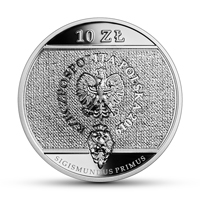
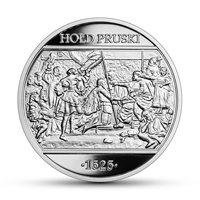
Hołd pruski … Nominał: 10 zł … Metal: Ag 925; Stempel: lustrzany;
Średnica: 32,00 mm; Masa: 14,14 g; Brzeg (bok): gładki;
Nakład: do 10 000 szt.; Projektant monety: Urszula Walerzak;
Emitent: NBP; Na zlecenie NBP monety wyprodukowała
Mennica Polska S.A.
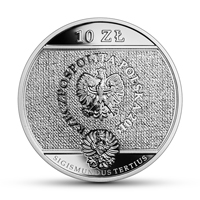
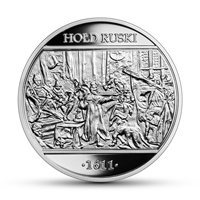
Hołd ruski … Nominał: 10 zł … Metal: Ag 925; Stempel: lustrzany;
Średnica: 32,00 mm; Masa: 14,14 g; Brzeg (bok): gładki;
Nakład: do 10 000 szt.; Projektant monety: Urszula Walerzak;
Emitent: NBP; Na zlecenie NBP monetywyprodukowała
Mennica Polska S.A. 1.
Wyobraźnię historyczną Polaków zdominował na kilka pokoleń Jan Matejko (1838−1893) i jego malarskie wizje. Dopiero dzisiaj, w epoce grafiki cyfrowej i rzeczywistości wirtualnej, wpływ Matejki nieco słabnie, ale jego dorobek wciąż jest ważnym punktem odniesienia dla tych Polaków, którzy jeszcze w ogóle interesują się historią. Monety upamiętniające „Hołd pruski, Hołd ruski” mają być przypomnieniem matejkowskiej wizji historii, ale też ważnych wydarzeń z dziejów Polski.
W twórczości Mistrza Jana motyw polskich zwycięstw nad państwami, które potem dokonały zaborów, był obecny od pierwszych, młodzieńczych jeszcze dzieł. Już w 1853 roku stworzył niewielki obraz sztalugowy „Carowie Szujscy przed Zygmuntem III”, który przypominał o klęsce Moskwy w wojnie z Polską na początku XVII wieku. Potem powstały wielkie malowidła historyczne głoszące chwałę dawnej Rzeczypospolitej i jej zwycięstw nad żywiołem rosyjskim i niemieckim – „Stefan Batory pod Pskowem” (1872) i „Bitwa pod Grunwaldem” (1878). Jeszcze później Matejko zaplanował dwa obrazy, których wspólnym motywem było przedstawienie obcego władcy na klęczkach, w geście hołdu składanego polskiemu królowi. W roku 1882 został ukończony „Hołd pruski”, przedstawiający przysięgę lenną księcia pruskiego Albrechta Hohenzollerna składaną Zygmuntowi Staremu w Krakowie w 1525 roku.
Dziesięć lat później Matejko zaplanował stworzenie kolejnego wielkiego malowidła historycznego, przedstawiającego hołd złożony Zygmuntowi III przez wziętego do niewoli cara moskiewskiego Wasyla Szujskiego i jego dwóch braci, co miało miejsce w Warszawie w roku 1611. W ramach tego planu powstał niewielkich rozmiarów obraz sztalugowy „Carowie Szujscy na Sejmie Warszawskim 1611 r.”, który był szkicem do panoramicznego dzieła zaplanowanego przez Mistrza Jana. Niestety Matejko nie zdążył go namalować i potomności pozostał tylko ów szkic, który jednak prędko stał się powszechnie znany i sławny pod potoczną nazwą nadaną przez polską publiczność – „Hołd ruski”. Określenie to nawiązywało w przejrzysty sposób do „Hołdu pruskiego” i tworzyło więź między oboma obrazami, choć wprowadzało też pewne terminologiczne zamieszanie.
W dawnej Rzeczypospolitej przymiotnika „ruski” używano do opisu zjawisk związanych z dziedzictwem Rusi Kijowskiej, ale istniejących w granicach Rzeczypospolitej. Państwo carów nazywano Moskwą, więc właściwe byłoby określenie „hołd moskiewski”. Jednak w XIX wieku inaczej już rozumiano owe terminy i władca Rosji potocznie nazywany był carem ruskim. Dlatego w pamięci społecznej utrwaliła się nazwa obrazu „Hołd ruski”. Dodatkową więź między obrazami stanowiły symbolizujące opisywane triumfy postacie dwóch Zygmuntów − dziadka i wnuka. Informacja: Henryk Litwin.

Prussian Homage Russian Homage (set of two coins)
www.nbp.pl
On 20 November 2019, Narodowy Bank Polski issued into circulation two silver coins, “Prussian Homage” and “Russian Homage”, with face values of 10 złoty. Collector coins of NBP Prussian Homage, Russian Homage. The image of a fragment of Jan Matejko’s painting The Prussian Homage from the collection of the Royal Castle in Wawel. All Polish collector coins feature: face value, an image of the Eagle established as the state emblem of the Republic of Poland, inscription: Rzeczpospolita Polska, year of issue. The Russian Homage … The image of a fragment of Jan Matejko’s painting Shuysky Tsars at the Warsaw Sejm from the collection of the National Museum in Cracow. The Photographic Studio of the National Museum in Cracow.


Prussian Homage … Face value: 10 zł … Metal: Ag 925; Finish:
proof; Diameter: 32.00 mm; Weight: 14.14 g; Edge (side): plain;
Mintage: up to 10,000 pcs; Designer: Urszula Walerzak; Issuer: NBP;
The coins, commissioned by NBP, were struck by Mennica Polska S.A.


Russian Homage … Face value: 10 zł … Metal: Ag 925;
Finish: lustrzany; Diameter: 32,00 mm; Weight: 14,14 g.;
Edge (side): gładki; Mintage: do 10 000 szt.; Designer: Urszula Walerzak;
Issuer: NBP; Na zlecenie NBP monetywyprodukowała Mennica Polska S.A. 1.
For several generations, the historical imagination of Poles has been dominated by Jan Matejko (1838-1893) and his painterly visions. Only today, in the era of computer graphics and virtual reality, is the influence of Matejko slightly fading, but his work continues to be an important reference point for those Poles who still take an interest in history. The coins commemorating “the Prussian Homage, the Russian Homage” are intended as a reminder of Matejko’s vision of history, but also landmarks in the history of Poland. In the work of Master Jan, the motif of Polish victories over the states which were to subsequently partition the country had been present since his first, still juvenile paintings.
Already in 1853, he created a small easel painting, Shuysky Tsars before Sigismund Vasa, recalling Moscow’s defeat in the war with Poland in the early 17th century. Later he created monumental canvases praising the glory of the former Republic and its victories over the Russian and German forces – Stephen Bathory at Psków (1872) and The Battle of Grunwald (1878). Later still, Matejko planned to paint two pictures with the common motif of a foreign monarch on his knees, in a gesture of tribute to a Polish king. In 1882, he finished The Prussian Homage, depicting the feudal oath made by the Prussian Duke Albrecht Hohenzollern to Sigismund the Elder in Cracow in 1525. Ten years later, Matejko made plans for another large historical painting presenting the homage paid to Sigismund Vasa by the captured Moscow Tsar Vasili Shuysky and his two brothers, which took place in Warsaw in 1611. As part of this plan, he created a small-sized easel painting, Shuysky Tsars at the Warsaw Sejm 1611, a sketch of the panoramic work planned by Master Jan. Regrettably, Matejko did not make it complete the painting and posterity was left with just the sketch, which was soon to become widely known and famous under the colloquial name coined by the Polish audience – The Russian Homage.
The name clearly alluded to The Prussian Homage and created a connection between the two paintings, at the same time giving rise to some terminological confusion. In former Poland, the adjective “Russian” was used to describe phenomena associated with the heritage of Kyiv Ruthenia, but existing within the borders of Poland. The state of the Tsars was called Moscow, so it would be adequate to use the name “the Muscovite Homage”. In the 19th century, however, these terms were understood differently, and the ruler of Russia was called the Russian Tsar. This is why the name “The Russian Homage” was engraved in people’s memory. An additional link between the paintings were the figures of two Sigismunds – a grandfather and a grandson – symbolising the depicted triumphs. Info: Henryk Litwin.


Newfoundland’s First Colonists
www.canadapost.ca https://postagestampguide.com
In 1610 King James I of England issued the Company of Adventurers and Planters of the Cities of London and Bristol a charter authorizing settlement of Newfoundland. The company chose John Guy, a merchant, and alderman of Bristol, as the proposed colony’s first governor. Guy recruited thirty-nine settlers, loaded three ships with goods and livestock, and sailed from Bristol. In June of 1610, he put in at Cuper’s Cove (now Cupids Cove) where he erected a stockade, built houses, and cleared land. In the spring grain was planted. The tiny colony, however, suffered from raids and depredations by pirates and hostile fishermen. Guy soon returned to England, and his settlement was left to its fate. (50-II-20)
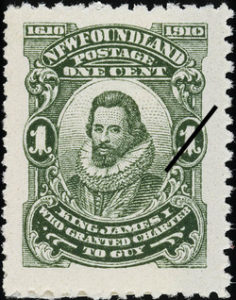
King James I who Granted Charter to Guy … Date of Issue: August 15, 1910; Denomination: 1¢; Perforation or Dimension: 12, 12 x 14, 12 x 11; Series: Guy Tercentenary; Series Time Span: 1910 – 1911; Postal Administration: Newfoundland. Based on a painting by Anthony van Dyck Engraved by MacDonald & Sons.
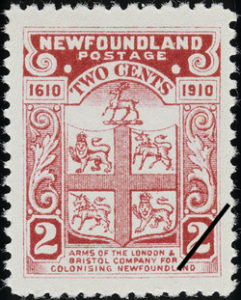
Arms of the London& Bristol Company for Colonizing Newfoundland … Date of Issue: August 15, 1910; Denomination: 2¢; Perforation or Dimension: 12, 12 x 14, 12 x 11.5; Series: Guy Tercentenary; Series Time Span: 1910 – 1911; Postal Administration: Newfoundland. Engraved by MacDonald & Sons.
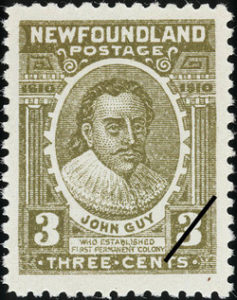
John Guy who Established First Permanent Colony … Date of Issue: August 15, 1910; Denomination: 3¢; Perforation or Dimension: 12; Series: Guy Tercentenary; Series Time Span: 1910 – 1911; Postal Administration: Newfoundland. Engraved by MacDonald & Sons.
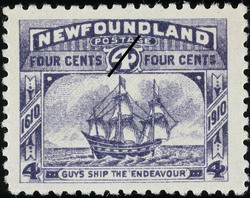
Guy’s Ship the”Endeavour” … Date of Issue: August 15, 1910; Denomination: 4¢; Perforation or Dimension: 12; Series: Guy Tercentenary; Series Time Span: 1910 – 1911; Postal Administration: Newfoundland. Engraved by MacDonald & Sons.
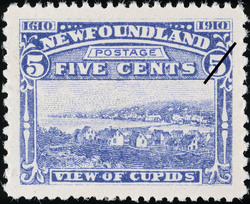
View of Cupids … Date of Issue: August 15, 1910; Denomination: 5¢; Perforation or Dimension: 12, 14 x 12; Series: Guy Tercentenary; Series Time Span: 1910 – 1911; Postal Administration: Newfoundland. Engraved by MacDonald & Sons.

Year of the Rat: PermanentTM Domestic Rate Stamps
www.canadapost.ca
Celebrate the Year of the Rat with this booklet of 10 PermanentTM domestic rate stamps. These festive stamps celebrate the Year of the Rat with images inspired by the Chinese folk tale of the wedding of the rat’s daughter. You’ll find the charming rat bride, dressed in extravagant headdress, being escorted to her wedding by merry rat servants. The Year of the Rat begins on January 25, 2020, and ends on February 11, 2021. Although Rat is the first sign in the Chinese zodiac, this is Canada Post’s final issue in the most recent 12-stamp Lunar New Year series.
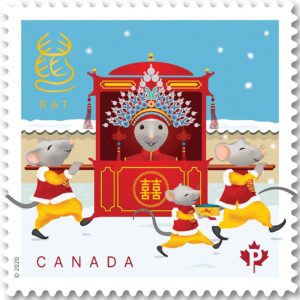
Stamp Value: PermanentTM (domestic rate) …
Quantity Produced: 260,000; Dimensions: 32 mm x 32 mm;
Stamp Designer: Albert Ng, O. Ont. and Seung Jai Paek;
Issue Date: January 17, 2020.
Year of the Rat: Booklet of 6 International Rate Stamps … Send warm wishes to welcome the Year of the Rat with this booklet of six international rate stamps featuring gold foil. These festive stamps celebrate the coming Year of the Rat with images depicting the Chinese folk tale of the wedding of the rat’s daughter. Showing the happily married couple after the ceremony, this stamp is depicted in the style of folk art known as Chinese farmer painting.
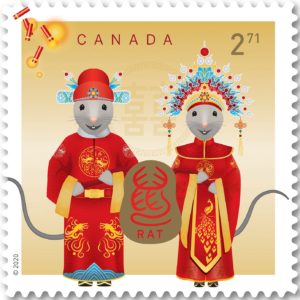
Stamp Value: $2.71 (international rate)…
Quantity Produced: 60,000; Dimensions: 32 mm x 32 mm;
Stamp Designer: Albert Ng, O. Ont. and Seung Jai Paek;
Issue Date: January 17, 2020.
Year of the Rat: Souvenir Sheet … Honour the arrival of the Year of the Rat with this scroll-shaped souvenir sheet featuring the international rate stamp. This souvenir sheet illustrates the traditional Chinese folk story of the wedding of the rat’s daughter. The stamp depicts the happily married couple as they share their first moments together after the elaborate ceremony. The background offers a glimpse of the merry procession that preceded the nuptials.

Stamp Value: $2.71 (international rate)…
Quantity Produced: 120,000; Dimensions: 40 mm x 140 mm;
Stamp Designer: Albert Ng, O. Ont. and Seung Jai Paek;
Issue Date: January 17, 2020.
Year of the Rat: Transitional Souvenir Sheet … Bid farewell to the Year of the Pig and welcome the arrival of the Year of the Rat with this transitional souvenir sheet featuring the international rate stamp from each issue. Both stamps feature embossing and gold foil and traditional blessings in Chinese calligraphy. At the top is the Year of the Rat stamp, depicting a newly wedded rat couple, with imagery of their wedding procession to the right. Below is the Year of the Pig stamp featuring Pigsy, a colourful character from the 16th-century Chinese novel Journey to the West.
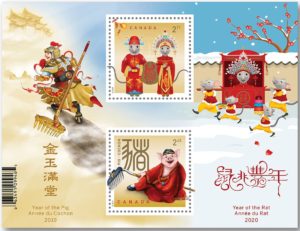
Stamp Value: 1 x $2.65, 1 x $2.71…
Quantity Produced: 60,000; Dimensions: 118 mm x 90 mm;
Stamp Designer: Albert Ng, O. Ont. and Seung Jai Paek;
Issue Date: January 17, 2020.

2020 … $3 Pure Silver Coin – Celebration of Love
www.canadapost.ca www.mint.ca
Our Celebration of Love coin is a message that comes from the heart. Its colourful flowers reflect the different shades of love: zinnias for friendship; forget-me-nots for a timeless connection; cosmos for feelings that run deep; and daisies for pure admiration. Packaged in a beautiful keepsake gift box, This 99.99% pure silver coin includes not one but two magnificent Swarovski® crystals that represent a special loving bond. The flowers in this design were chosen to represent love in all its forms: kinship, friendship and/or partnership. It’s the perfect gift for any loved one, on any occasion, whether you’re celebrating a birthday, wedding, or anniversary—or simply just because!
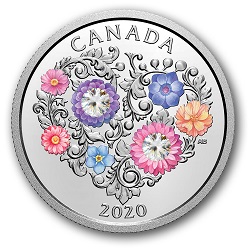
Face value: 3 dollars … Composition: 99.99% Pure Silver;
Mintage: 15,000; Finish: proof; Weight: 7.96 g; Diameter: 27 mm;
Artist: Anna Bucciarelli (reverse), Susanna Blunt (obverse).

2020 … $10 Pure Silver Coin – Year of the Rat
www.canadapost.ca www.mint.ca
This coin celebrates the Rat’s symbolism as a bringer of joy and longevity. It features a Rat jumping among the branches of a pine tree, an evergreen that is treasured for its strength and longevity. Together, they remind us that life is best lived in balance where maturity knows youthful enthusiasm, wisdom finds wit, and stoicism can reverberate with playful energy. It’s a cherished, universal message for all struck in the Mint’s unique specimen finish. Hidden elements add to this coin’s allure and intrigue. Find the Chinese character for “Rat” hidden on its body, as well as a good luck coin motif, and auspicious patterns of peonies and plum blossoms. Authentic Chinese design features the distinctive style of Asian folk art beautifully engraved on this coin. Most affordable rat coin is crafted in ½ ounce of 99.99% pure silver—prestige on a budget!
The perfect gift—for the rat in your life! This coin’s universal design will captivate anyone with a fondness for rats. It’s the ideal keepsake for friends or loved ones born in the Year of the Rat (2020, 2008, 1996, 1984, 1972, 1960, 1948, 1936, 1924). A must-have for zodiac enthusiasts and anyone with an interest in the fascinating traditions and culture of ancient China. Only the Mint produces coins with the renowned specimen finish that features brilliant and frosted relief on a matte background—stunning in pure silver.
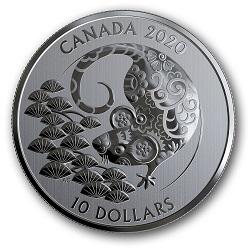
Face value: 10 dollars … Composition: 99.99% pure silver;
Mintage: 18,888; Finish: Specimen; Weight:15.87 g;
Edge: serrated; Certificate: serialized; Diameter: 34 mm;
Artist: Aries Cheung; Susanna Blunt (obverse).
Design: Canadian artist Aries Cheung created this delightful design of a rat jumping among the branches of a pine tree. Clusters of pine needles look fan-like as they sweep up the left side of the coin field. On the right, a playful rat dive into the branches with one paw stretched out to its left. The rat’s agile body curves along the outer edge of the field and its tail curls inward just above the pine branches to unify the composition. The Chinese character for “rat” is engraved on the rat’s flank while a good luck coin motif adorns its back, and auspicious peonies and plum blossoms fill the remainder of its body. “CANADA 2020” and “10 DOLLARS” are engraved above and below the design. The obverse features the effigy of Her Majesty Queen Elizabeth II by Susanna Blunt with “ELIZABETH II D.G. REGINA” engraved along the outer edge of the coin.
Did you know…*The rat is a central figure in numerous creation myths. It chewed open a gourd to release heaven and Earth that were trapped inside, and gnawed a hole in the sky to set spirits free. Some Asian cultures have temples dedicated to the gentle and benevolent rat. *Lucky symbols for Rat people include the numbers two and three, the colours blue, gold and green, as well as the lily and African violet. *Famous Canadian Rat personalities include Bobby Orr, Margaret Trudeau, David Suzuki, Elvis Stojko and Stompin’ Tom Connors. HRH Prince Charles, Prince Harry, and Winston Churchill are also Rats. *Chinese New Year shifts every year due to the lunar cycles. This affects the zodiac for people born in January and February. For example, the Year of the Rat begins on January 25, 2020 and ends on February 11, 2021.

2020 … Pure Silver Lunar Lotus Coin – Year of the Rat
www.canadapost.ca
An intriguing lotus-shaped coin to celebrate the clever and likeable Rat. The Rat may be the smallest zodiac, but its clever and charming ways won it the first spot in the Chinese lunar calendar. There’s always something brewing in the Rat’s razor-sharp mind. These enterprising individuals are incredibly curious and quick to ferret out an opportunity. They can be rather forward, but their honest and candid ways put everyone at ease. Rat people are remarkably easy to get along with. They are bright, fun loving, and care deeply about the people in their lives. Rat people succeed at virtually everything they do, but business is where they truly shine. They can strategize and stretch finances like no other. If you receive an extravagant gift from a Rat, know that you are cherished and prized indeed! An original and prestigious gift for that special Rat person in your life, or any newborn due this year—between January 25, 2020 and February 11, 2021. Other years include: 2008, 1996, 1984, 1972, 1960, 1948, 1936, 1924.
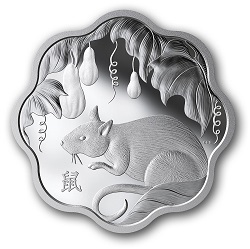
Face value: 15 dollars … Composition: 99.99% pure silver;
Mintage: 15,888; Finish: Proof; Weight: 26.7g;
Edge: plain; Certificate: serialized; Diameter: 38 mm;
Artist: Three Degrees Creative Group (reverse).
Design: Three Degrees Creative Group has created an endearing portrait of the clever and likeable Rat sitting beneath Chinese gourds. The Chinese character for “Rat” is engraved to the Rat’s left.
Did you know… *Legends abound how the tiny rat became the first sign in the Chinese zodiac when the Lord Buddha summoned all the animals. Many claim the Rat hitched a ride on the kind and helpful Ox, and jumped off at the last moment to get there first. While the Horse was arguably a faster option, some legends claim the high-spirited Horse refused to cooperate, or was too polite to race ahead of the others. *Lucky symbols for Rat people include the numbers two and three, the colours blue, gold and green, as well as the lily and African violet. *The Rat is happiest with the Dragon, Ox or Rabbit, and will achieve great things when teamed up with the Dog or Monkey. The Rat lacks patience when dealing with the Rooster and will never get along with the fiery Horse. It’s the polar opposite of the Rat’s water element.

2020 … $15 Pure Silver Coin – Year of the Rat
www.canadapost.ca www.mint.ca
Celebrate a friend or loved one born in the Year of the Rat… Everyone will be charmed by this delightful pure silver coin featuring the amiable and crafty Rat. It’s the smallest of the Chinese zodiacs, but its quick mind won it first spot in the Chinese lunar calendar. These enterprising individuals are incredibly curious and quick to ferret out an opportunity. They can be rather forward, but their honest and candid ways soon put everyone at ease. Rat people are remarkably easy to get along with. They are bright, fun loving, and care deeply about the people in their lives. They succeed at virtually everything they do, but business is where they truly shine. Rat people can strategize and stretch finances like no other. If you receive an extravagant gift from a Rat, know that you are cherished and prized indeed! A unique gift for that special Rat person in your life, or the newborns due between January 25, 2020 and February 11, 2021. Authentic Chinese design captures the essence of the clever and likeable Rat personality, complete with the Chinese character for “Rat.” Prestigious proof finish features a frosted design on a mirror-like background that has been hand polished to perfection. A must-have for zodiac enthusiasts and anyone with an interest in the fascinating traditions and culture of ancient China.
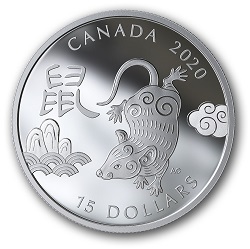
Face value: 15 dollars … Composition: 99.99% pure silver;
Mintage:10,888; Finish: Proof; Weight: 31.39 g;
Edge: serrated; Certificate: serialized; Diameter: 38 mm;
Artist: Aries Cheung; Susanna Blunt (obverse).
Design: Canadian artist Aries Cheung has created an endearing design of a Rat in its character pose as it explores the field of the coin. Seen from above, the Rat is positioned between lucky waves to the left and auspicious clouds to the right, their swirling contours echoed in the Rat’s fur to bestow good fortune upon this zodiac sign. The Chinese character for “Rat” is engraved above the waves.

2019 … $50 Pure Silver Coin – The Centennial Flame of Canada
www.canadapost.ca www.mint.ca
A small-scale replica that is big on depth. Beyond the Queen’s Gate on Parliament Hill lies a fire-topped monument to Canadian unity. Ultra-high relief has allowed us to take coin designs to greater heights than ever. And now we’ve added incredible depth to our latest engineering marvel: a 13-sided (tridecagon) coin-sized replica of the Centennial Flame monument on Parliament Hill. The realistic rendering was made possible by a dramatic variation in relief height: the deep sunk basin gives this coin a minimum thickness of 1.51 millimetres, which soars to 5.05 millimetres when measured from the tip of the engraved flame. An antique finish also gives this coin a more weathered appearance—like the granite-and-bronze fountain that celebrates Canadian unity.
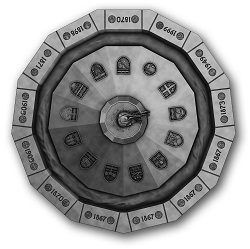
Face value: 50 dollars … Composition: 99.99% pure silver;
Mintage: 2,500; Finish: antique; Weight: 93.31 g;
Diameter: 60 mm; Edge: plain, 13-sided;
Certificate: serialized; Artist: Susanna Blunt (obverse).
Design: On the reverse, an engraved flame tops this small-scale replica of the Centennial Flame monument on Parliament Hill in Ottawa, Ontario. The 13-sided fountain consists of one panel for every Canadian province and territory, which are represented by their armorial bearings. On the edge of the fountain basin, the province or territory’s floral emblem frames its date of entry into Confederation. An antique finish adds a weathered look that emphasizes the deep sunk relief. The obverse features the effigy of Her Majesty Queen Elizabeth II by Susanna Blunt.
“Since the fountain is such an iconic landmark, we were inspired to push the limits to achieve the dramatic relief changes seen here. It was a challenge, but we were able to perfect the coin in just a few physical trials by using our cutting-edge Virtual Minting process. It allowed us to pre-determine the amount of silver and the striking force necessary to create our version of the monument.” Jennifer Baba, Product Engineering Intern, Royal Canadian Mint.
“This coin is a fantastic combination of design and technology. You can almost imagine throwing a coin into the fountain when you see the great depth achieved with this piece.” Erica Maga, Product Manager.
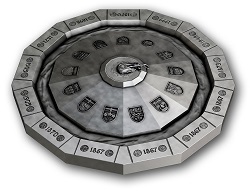
Did you know… * Prime Minister Lester B. Pearson first lit the flame on December 31, 1966. The Centennial Flame was intended to be a temporary installation for the centennial celebrations in 1967. By popular demand, it became a permanent addition to the public grounds of the Parliament Buildings in Ottawa. * Fuelled by natural gas, the heat from the flame keeps the waters flowing — even on the coldest winter days. But it’s not an eternal flame: it has been extinguished a few times, largely for maintenance work. * In 2017, the 12-sided fountain was updated to include a 13th panel representing Nunavut. (Nunavut entered Confederation on April 1, 1999, three decades after the fountain was originally built.) * Make a wish and throw a coin into the fountain for luck — you’ll also help fund disability research! Coins tossed into the fountain are regularly collected and put towards the annual Centennial Flame Research Award.


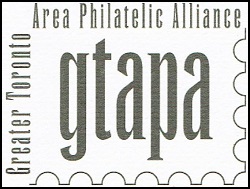
www.gtapa.org
The GTAPA is committed to promote and stimulate the art of philately
to all ages for fun, culture, education, and friendship.




